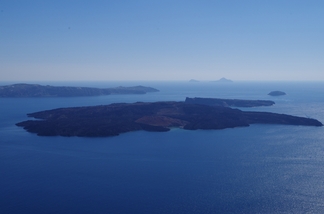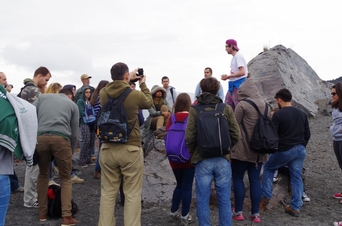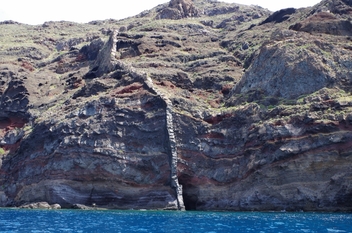 Nea Kameni, located almost centrally in the caldera Nea Kameni, located almost centrally in the caldera Thanks to Tom for inviting me to contribute this blog-post. I should start by telling you a little about me and how I know Tom, so here goes. I am a PhD student at Royal Holloway, University of London, researching volcano-tectonics and specifically the mechanics of caldera collapses. Like Tom I also studied for a Master’s degree in Volcanology and Geological Hazards at Lancaster University, although we did not meet at Lancaster. I first met Tom in May 2013 for a NEMOH organised field school at Stromboli volcano; where we jointly experienced an unfortunately unforgettable, and particularly rough boat back to the mainland of Sicily. I can highly recommend that if the captain of a sketchy looking boat offers to get you off an island when none of the main companies are willing to, think again! So, Tom asked me to write this post as he heard that I was working at a really fascinating and important volcano in Greece. The volcano in question is Santorini, which is a particularly famous stratovolcano in the Aegean ocean. The volcano is famous partly because around 3500 years ago the island experienced a huge caldera forming eruption, which is believed to be associated with the demise of the Minoan civilisation. Deposits from the various phases of the eruption can be seen straddling almost the entire circumference of a north-south elongated caldera, which measures approximately 10 km in maximum diameter, several hundred metres in depth and is centrally filled by ocean. In fact, at least three huge eruptions, ~100 thousand years, ~21 thousand and ~3500 years ago contributed to the shape and size of the current caldera. The global impacts of the Minoan eruption have often been overestimated (see the article of Pyle, 1995), however in terms of volume this eruption is up there with the biggest of the past 10,000 years. Active volcanism in Santorini is now constrained to a small island named Nea Kameni, located almost in the centre of the caldera. This resurgent volcano has been the site of several predominantly effusive eruptions, the latest of which occurred in 1950. Importantly, the island of Santorini lies on top of two north-east to south-west trending faults, one in the north of the island is called the Colombo fault and the other which is believed to be associated with the current phase of volcanism lies directly under Nea Kameni, and is named the Kameni fault.  Giving a lecture in the field. Giving a lecture in the field. OK, so what was I doing in Santorini? The answer is looking for and studying dykes in the caldera walls. Just so you’re up to speed, a dyke is a magma-driven fracture through which all volcanic eruptions must be fed. As such, it is really important to know the conditions for dyke propagation in a volcanic edifice. Luckily there are many fantastic geological locations (e.g. Iceland/Tenerife) around the world where geologists can see deep inside ancient volcanoes. In doing so it is possible to observe that many dykes (if not most) never reach the surface, and therefore never contribute to a volcanic eruption. They become arrested. Santorini is a stratovolcano made up of many layers of contrasting mechanical properties; for example, stiff lava flows and comparatively compliant layers such as ash, volcanic tuffs and breccia’s. So it offers a great opportunity to try to understand how dykes pass through these individual layers. Specifically, I went into the field to take measurements on the thicknesses, directions and compositions of individual dykes. The walls of the caldera are very steep and largely inaccessible, so most of my work was conducted from a boat, which was a really cool experience. The data is important for me because I am trying to understand how calderas form in different volcanoes. I am using the propagation of dykes as a proxy for the propagation of caldera fractures, because presumably the fracture which created the current caldera must have passed through the same materials with which these dykes also passed.  A dyke cuts through several different layers in the caldera wall A dyke cuts through several different layers in the caldera wall In 2011, Santorini experienced an unrest period characterised by elevated levels of seismicity and uplift (see Parks, 2012 for details). Such signals are most likely associated with magma being transported as dyke from great depths, to recharge a shallow magma chamber. When and why a magma chamber ruptures and sends a dyke to the surface is still a reasonably poorly understood phenomenon. So the important question at most caldera volcanoes is: when does a period of unrest lead to a volcanic eruption? It is a difficult one to answer! As well as gathering data for my PhD I also took the time to help out at the run-off erosion intensive field-course organised by the University of Athens. Sandy Drymoni and I ran the course’s final day visit to Nea Kameni, where we introduced some basic volcanological concepts and described some of the islands features. This was a very rewarding and enjoyable experience. The previous day I also had the opportunity to meet the mayor of Santorini at a visit to the Minoan ruins at Akrotiri. Although I wasn’t able to question him about the island’s volcanic preparedness, this was partly out of courtesy, but mainly because we didn’t speak any of the same languages. I will now use the data collected from this fieldwork as an input for numerical models using the structural mechanics module of a program called COMSOL. In doing so, I will try to understand the stress conditions required for dyke propagation; caldera formation and magma chamber rupture in different types of volcanic edifice. Comments are closed.
|
Archives
July 2023
|


 RSS Feed
RSS Feed